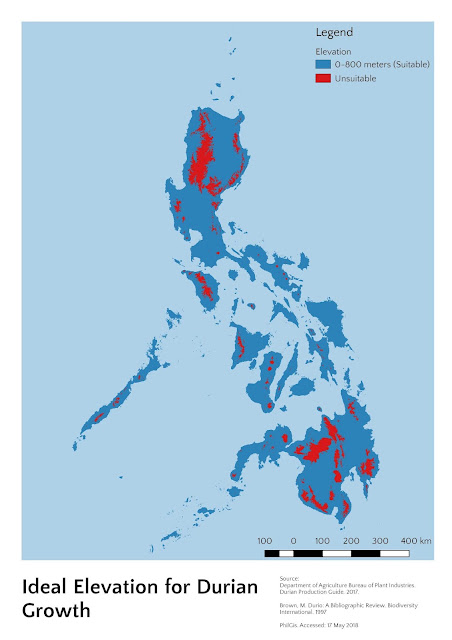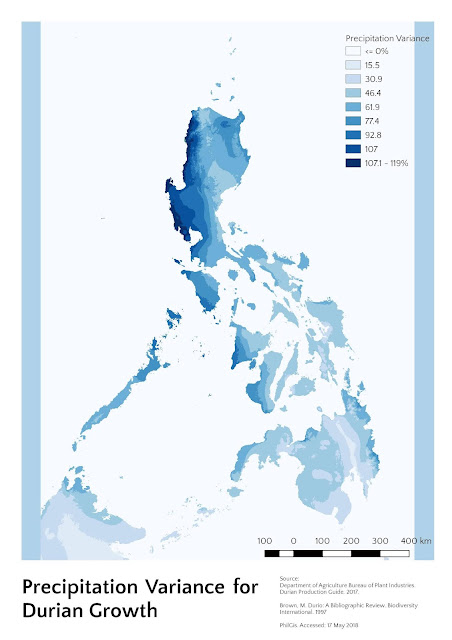Can Durian Grow Beyond Mindanao?
Durian, the majestic "King of Fruits." Well-loved and well-respected for its patrons (like I do), loathed and cursed by its detractors. Its characteristic aroma (not odour) and flavour has fascinated and repulsed people from all corners of the globe. In Southeast Asia, it is sold on streets as fruits, pulp, candy, or to the extreme--durian pizza. Durio zibenthus, its scientific name, was once described by British naturalist Alfred Russel-Wallace in his journey in Asia.
 |
| Durian marketplace near Magsaysay Park at Davao City, Philippines |
In the Philippines, durian is often associated with Mindanao, where most of the production comes from. However, my recent move to Laguna had me bought several kilos of durian in 2019--particularly at the foothills of Makiling where I can buy PhP50-PhP80 per kilo. It made us thought if we can plant durian beyond Mindanao. Because of our love with durian, we made a short research paper in our Biogeography class at grad school, on where in the Philippines can we grow durian.
The Usual Range
 |
| The number of durian fruit bearing trees in the Philippines as per DA. Most of these are located in Mindanao, particularly Davao Region and Caraga. |
The native range of durian spans over Indonesia, Malaysia, Brunei, and even Thailand and here in the Philippines. However, its distribution as an economic crop in the Philippines comes mostly from the Island of Mindanao, within the vicinity of Borneo. As to how durian came in Mindanao or Sulu is still subject to further research, but given its vicinity within its native range, most likely it may have been brought either through human intervention or may have been carried by natural causes.
 |
| Map of ideal annual mean temperature for durian. Most of the areas of the country is ideal for growth based on temperature parameters. |
Philippine Statistics Authority (PSA) has noted that more than 16,000 hectares of land in the country are devoted to the plantation of durian in 2016. 50 percent of it comes from Davao Region. Agusan del Sur has the largest durian plantation outside of Davao followed by Cotabato Province. Even Sulu has around 700 hectares. Davao City is the country's largest producer of durian in 2016.
 |
| Map of ideal soil for durian growth. According to Department of Agriculture, sandy loam or clay loam are the favoured soil conditions |
Production of durian outside Mindanao pales in comparison. Western Visayas accounts the largest outside Mindanao with almost 170 hectares in total with Negros Occidental and Iloilo's production combined.
 |
| Ideal elevation growth of durian in the Philippines. The highlands are the only areas that are not ideal for growth. |
Surprisingly, the government statistics agency has noted production in Luzon. Particularly in Laguna, Aurora, Ilocos Sur, and Nueva Vizcaya--far beyond the "traditional" range. We even remember Oriental Mindoro having that too. That means, planting that ooh so loving fruit can get closer to Manila--wherein they sell durian to almost PhP200 to PhP400 per kilo!
 |
| Ideal slope for durian growth in the Philippines. It prefers flatter or gentle slopes over steep ones, |
Finding the Suitable Place to Grow
There have been recommendations on where to grow durian. Why is it Mindanao is "the king" of durian production? We made some studies and here are some of the ideal requirements of planting and growing durian:
- Sandy Loam or Clay Loam. According to the Department of Agriculture-Bureau of Plant Industry, they thrive in these kind of soil.
- Sea Level to 800 meters (2,624 ft) above sea level. It dismisses the fact that durian prefers higher ground as popularly believed.
- Tropical climate with well-distributed rainfall. Most durian trees thrive in our climate. Philippines is a tropical country like its neighboring ASEAN neighbors. However, in Koppen-Geiger Climate Classification, the one that best describes this is a Tropical rainforest climate (Af).
- 22 to 33 degrees Celsius. These are your average tropical temperatures.
- Slopes of 0-25 degrees. They prefer flat to gradual slopes.
 |
| Annual precipitation of durian. |
With these in mind, we made some analysis using Geographical Information System (GIS) through raster and visual overlay analysis using available data from Shuttle Radar Topography Mission (SRTM) DEM map from NASA, or the slope and elevation of the terrain, from WorldClim’s Bioclimatic variables: annual mean temperature, annual precipitation, and precipitation variance, and PhilGiIS for the general soil map of the Philippines. (My laptop crashed several times because it could not compute the data with its limited processor and memory).
For the love of durian, we analyzed
After a lot of laptop crashes and sleepless nights, we were able to analyze the data based on the prescribed ideals for growing durian:
- Well-distributed rainfall was the deal-breaker. While Philippines offers a lot of land with sandy and clay loam, temperature variance, and slopes, it is to Mindanao's advantage of having a well-distributed rainfall. Most of the island falls in Tropical rainforest climate, or Philippine Type III Climate (Coronas), having less precipitation variance than the rest of the country.
- Luzon lacks well-distributed rainfall except areas with ideal microclimate - Despite having large tracks of land ideal for durian plantations, it is the distribution of rainfall that mattered. The fact that there are recorded durian production in some parts of Luzon meant that, in hypothesis, it may have been affected by orographic (or effects of mountains or terrain) lift influences, or mountains play a key role in giving a well-distributed rainfall. Foothills of the Cordilleras or Caraballo, Mount Banahaw and Makiling may have this kind of microclimate that makes it ideal to plant durian.
- Basilan has a great potential due to its geological and climatological factors.
- In the Visayas, the following areas have potential, but it does not have vast tracts of land like Mindanao:
- Parts of Cebu
- Parts of Bohol
- Parts of Negros Occidental
- Northern Iloilo
It was just a beginning to know more about our favourite fruit. While it still needs further study, analyzing the country's geological and climatological requirements is a tool where farmers can probably invest in planting durian.
Bottom line, to answer the question, yes. It can grow and propagate beyond Mindanao.
For the research paper, you may read further here:
https://www.researchgate.net/publication/325381622_Going_Beyond_The_Case_of_Durian_Industry_in_the_Philippines_and_Finding_Suitable_Areas_beyond_Mindanao_Island
This study was presented on the National Conference on Geographical Studies in 2018 (NCGS 2018) at University of the Philippines Diliman.
References
Philippine Statistics Authority. 2016. Other Crops: Area Planted/Harvested by Region and by Province, 1990-2016.
Philippine Department of Agriculture –Bureau of Plant Industry. 2017. Durian Production Guide 2017.
Hariyono, D., Ashari, S., Sulistyono, R., Aini, N.,2013. The Study of Climate and its Influence on the Flowering Period and the Plant’s Age on Harvest Time of Durian Plantation (Durio zibethinus Murr.) on Different Level of Altitude Area. Journal of Agriculture and Food Technology.
Suaybaguio, M., Odtojan, R., 1992.The Effect of Rainfall Pattern on the Flowering Behavior of Durian. Philipp J. Crop Sci. Vol. 17 No. 3 1992.
Brown, M., 1997. Durio—A Bibliographic Review. International Plant Genetic Resources Institute.
Wallace, A.R.1856. On the Bamboo and Durian of Borneo. Accessed: https://people.wku.edu/charles.smith/wallace/S027.html
Philippine Department of Agriculture –Bureau of Plant Industry. 2017. Durian Production Guide 2017.
Hariyono, D., Ashari, S., Sulistyono, R., Aini, N.,2013. The Study of Climate and its Influence on the Flowering Period and the Plant’s Age on Harvest Time of Durian Plantation (Durio zibethinus Murr.) on Different Level of Altitude Area. Journal of Agriculture and Food Technology.
Suaybaguio, M., Odtojan, R., 1992.The Effect of Rainfall Pattern on the Flowering Behavior of Durian. Philipp J. Crop Sci. Vol. 17 No. 3 1992.
Brown, M., 1997. Durio—A Bibliographic Review. International Plant Genetic Resources Institute.
Wallace, A.R.1856. On the Bamboo and Durian of Borneo. Accessed: https://people.wku.edu/charles.smith/wallace/S027.html




